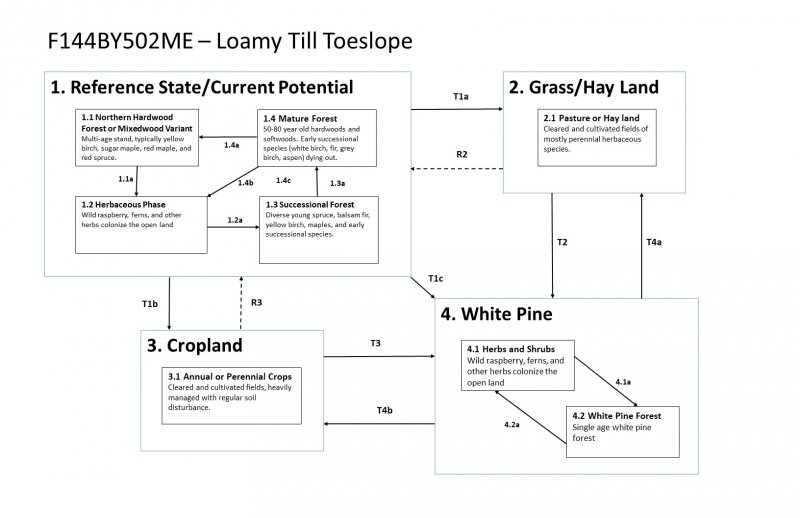
Natural Resources
Conservation Service
Ecological site F144BY502ME
Loamy Till Toeslope
Last updated: 9/27/2024
Accessed: 12/22/2025
General information
Provisional. A provisional ecological site description has undergone quality control and quality assurance review. It contains a working state and transition model and enough information to identify the ecological site.
MLRA notes
Major Land Resource Area (MLRA): 144B–New England and Eastern New York Upland, Northern Part
This major land resource area (MLRA) is in Maine (56 percent), New Hampshire (22 percent), Vermont (14 percent), Massachusetts (6 percent), Connecticut (1 percent), and New York (1 percent). It makes up about 22,728 square miles (58,864 square kilometers). The MLRA consists of a relatively young landscape shaped by the Laurentide Ice Sheet, which covered the region from 35,000 to 10,000 years ago. Rolling hills of dense basal till converge on ridges of shallow bedrock that were scoured by glacial ice. River valleys that were flooded by melting glacial water or seawater house large expanses of glacial outwash and stratified drift in inland areas and, to a lesser extent, glaciomarine and glaciolacustrine sediment deposits in coastal areas. Organic bogs, ablation till, and alluvial flood plains make up the remaining portions of the MLRA.
The soils in this region are dominantly Entisols, Spodosols, and Inceptisols. They commonly have a fragipan. The dominant suborders are Ochrepts, Orthods, Aquepts, Fluvents, and Saprists. The soils in the region dominantly have a frigid soil temperature regime with some cryic areas at higher elevation, a udic soil moisture regime, and mixed mineralogy. Most of the land is forested, and 98 percent is privately owned. Significant amounts of forest products are produced including lumber, pulpwood, Christmas trees, and maple syrup. Principal agricultural crops include forage and grains for dairy cattle, potatoes, apples, and blueberries. Wildlife habitat and recreation are important land uses. Stoniness, steep slopes, and poor drainage limit the use of many of the soils.
Classification relationships
NRCS:
Land Resource Region: R—Northeastern Forage and Forest Region
MLRA: 144B—New England and Eastern New York Upland, Northern PartMLRA resources
Major Land Resource Area (MLRA): 144B–New England and Eastern New York Upland, Northern Part
Ecological site concept
This site occurs on gentle foot and toe slopes (0-15%) at the base of watersheds where water and nutrients accumulate near slope breaks. Soils are underlain by a densely compacted till layer within 27 inches of the soil surface, which perches water and nutrients in the plant rooting zone. Occasionally groundwater seeps out at the surface, leaving rivulets as useful site indicators. The resulting plant community is highly-productive and most commonly dominated by northern hardwoods, though red spruce and balsam fir are often abundant, particularly in flatter areas. Abundant yellow birch is a good indicator of this site.
Relationship to Other Classification Systems
This site includes the following state natural heritage program types:
• Semi-rich Mesic Sugar Maple Forest (Sperduto and Nichols 2004)
• Sugar Maple – Beech – Yellow birch Forest (Sperduto and Nichols 2004)
• Hardwood Seepage Forest (Gawler and Cutko 2010)
• Spruce-Northern Hardwoods Forest (Gawler and Cutko 2010)
• Sugar maple-beech-yellow birch forest (Thompson and Sorenson 2000)
• Semi-rich Mesic Sugar Maple Forest (Thompson and Sorenson 2000)
Associated sites
| F144BY301ME |
Loamy Till Swamp The Loamy Till Swamp site occurs lower in the watershed than the Loamy Till Toeslope site. The two sites occur together along a soil drainage gradient from somewhat poorly to poorly- and very poorly-drained. |
|---|---|
| F144BY501ME |
Loamy Slope (Northern Hardwoods) The somewhat poorly- and poorly-drained Loamy Till Toeslope site often occurs downslope of the moderately well- and well-drained Loamy Slope site |
| F144BY504ME |
Enriched Loamy Cove The Enriched Loamy Cove site is richer than the Loamy Till Toeslope and occurs in areas where the most amount of nutrients accumulate, such as small drainageways |
Similar sites
| F144BY507ME |
Semi-rich Till Toeslope The Semi-rich Till Toeslope site has similar soil texture and wetness, but is distinguished by higher soil nutrients derived from calcareous parent material (such as limestone), as evidenced by high soil pH and rich site indicator species (particularly basswood). |
|---|---|
| F144BY501ME |
Loamy Slope (Northern Hardwoods) The Loamy Slopes site is predominantly well and moderately well-drained soils (sometimes with somewhat poorly-drained inclusions) that produce mostly northern hardwoods, whereas the Loamy Till Toeslopes site consists of somewhat poorly- to poorly drained soils and can produce more mixedwood stands. |
| F144BY402ME |
Clay Hills While these two sites produce similar forests, Clay Hills occur on better-drained, finer-textured soils, usually of glaciomarine or glaciolacustrine origin, while the Loamy Till Toeslope site occurs on till soils that are typically coarser in texture and poorly- to somewhat-poorly drained. The Loamy Till Toeslope site is thought to be more productive than the Clay Hills site (not confirmed). |
| F144BY504ME |
Enriched Loamy Cove The Enriched Loamy Cove site occurs along drainageways, produces hardwood forests (typically with white ash, yellow birch, sugar maple, and/or beech), has a thick dark soil surface horizon, and has rich site indicators. By contrast, the Loamy Till Toeslope occurs at the base of slopes and produces semirich hardwood or mixedwood stands. |
| F144BY503ME |
Loamy Flat The Loamy Flat site and Loamy Till Toeslopes site share many of the same soils, but Loamy Flats occur on flatter areas grading into wetlands and produce spruce-fir forests, whereas the Loamy Till Toeslope occurs at the base of slopes and produces semi-rich mixedwood forests. |

Figure 1.
Table 1. Dominant plant species
| Tree |
(1) Pinus strobus |
|---|---|
| Shrub |
Not specified |
| Herbaceous |
Not specified |
Click on box and path labels to scroll to the respective text.
